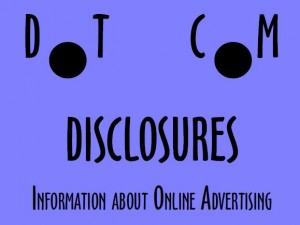 It’s becoming even more important to disclose the work you do with clients, particularly if it isn’t clear you’re working with a company on their online efforts.
It’s becoming even more important to disclose the work you do with clients, particularly if it isn’t clear you’re working with a company on their online efforts.
The FTC recently released their “Dot Com Disclosures,” (PDF download) which spells out what is OK and what is not.
Our own Lisa Gerber wrote a blog post a few weeks ago, detailing why we write (client) on things we tweet, Facebook, pin, update, or connect on behalf of clients.
In the comments, she got a lot of flack, ranging from “people won’t read it if you say it’s on behalf of a client” to “that’s ridiculous.”
Well, now it doesn’t matter whether or not you think it’s ridiculous. It’s no longer just a guide or a rule, it’s now required.
The disclosure must be clear and conspicuous.
The Dot Com Disclosures says, to evaluate whether a particular disclosure is clear and conspicuous, consider:
- The placement of the disclosure in an advertisement and its proximity to the claim it is qualifying;
- The prominence of the disclosure;
- Whether items in other parts of the document, tweet, update, connection, blog post, ad, etc., distract attention from the disclosure;
- Whether what is being communicated is so lengthy that the disclosure needs to be repeated;
- Whether disclosures in audio messages are presented in an adequate volume and cadence and visual disclosures appear for a sufficient duration; and
- Whether the language of the disclosure is understandable to the intended audience.
It even goes so far as to say the disclosure cannot be linked to a separate page, which causes the consumer to “refer somewhere else to obtain the disclosure,” but that it can be hyperlinked after the first mention, particularly in lengthy content that requires it more than once.
If you’re working on something that requires an online purchase, a disclosure must be made before the purchase page and on it, as well.
They’re even suggesting disclosure be a different color, size, and/or background of the document it’s within so it’s very clear what’s being said.
Of course, the most obvious example of this is when you buy an ad and get a feature story in return. Those stories must say “advertising” along the top or in some form throughout the copy.
But it’s no longer limited to printed publications. It’s considering all content on the web as part of the Dot Com Disclosures Act. And you have to be prepared.
They’re considering this part of the consumer protection laws and they will come after you.
Protect yourself, your company, and/or your clients. Disclose. Better to be safe than sorry.
(I linked to it above, but if you want to get really smart on the Dot Com Disclosures, you can find it here.)